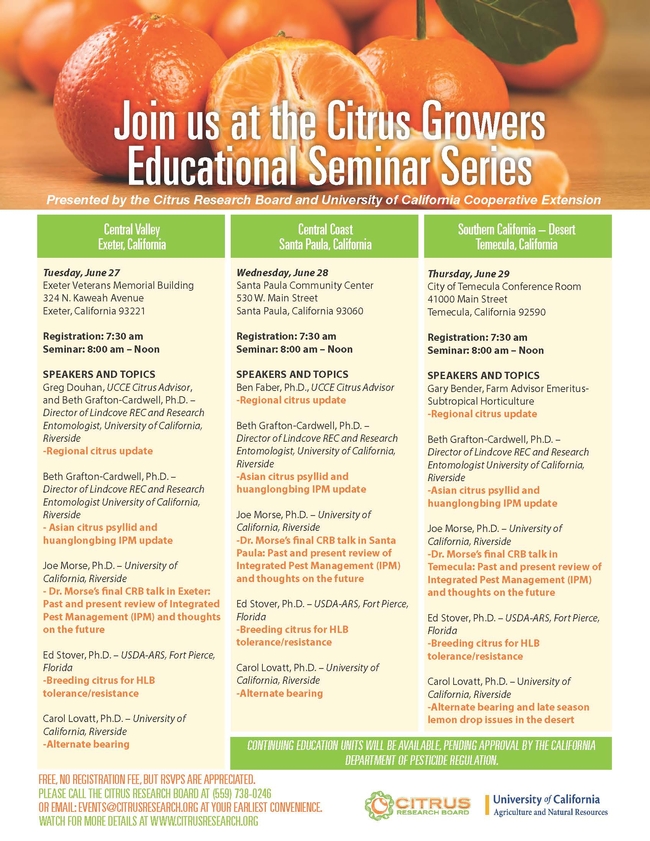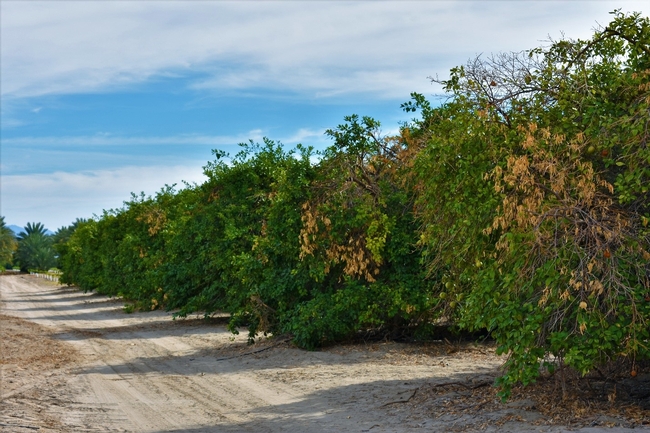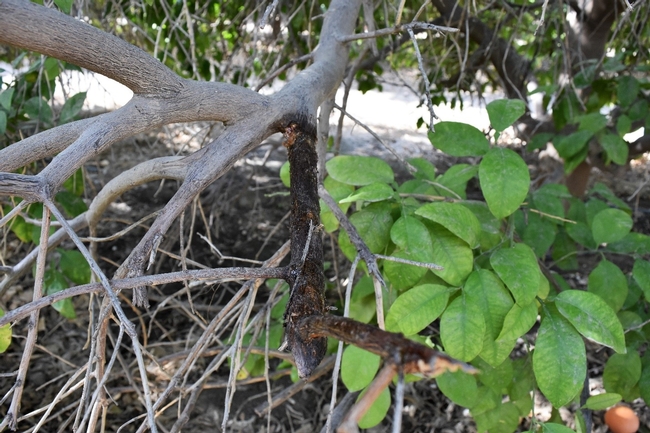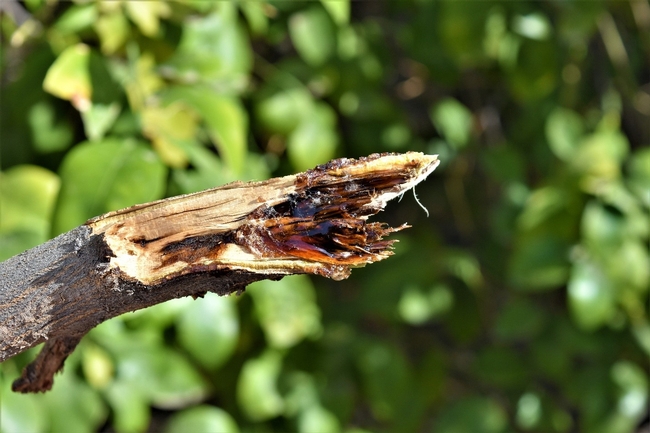- Author: Ben Faber
Now we know
A team of researchers, including two from the University of California, Riverside, has identified the genes responsible for the hallmark sour taste of many citrus fruits. Published Tuesday, Feb. 25 in Nature Communications, the research could help plant breeders develop new, sweeter varieties.
Modern citrus varieties have been bred over thousands of years to generate a broad palette of sour and sweet-tasting fruits. Analyses of their pulp reveals that a single chemical element--hydrogen--is largely responsible for the difference between sour and sweet-tasting varieties, which usually have similar sugar content. The pulp from sour fruits contains more hydrogen ions, giving it a lower pH and a tangy taste that is recognized by acid-sensitive cells in our taste buds. Conversely, pulp from sweeter varieties contains fewer hydrogen ions and tastes less acidic.
Ronald Koes and colleagues at the University of Amsterdam in the Netherlands set out to untangle how some citrus varieties wind up with more acidic juice than others, a process that until now has remained a mystery. Their interest stemmed from a previous study showing that higher acidity in purple petunia flowers resulted in more petal pigmentation.
Intrigued by the Faris variety of lemon tree, which produces branches bearing both sweet and sour fruits, and white and purple-tinged flowers, Koes' team turned to UCR plant scientists Mikeal Roose and Claire Federici. Using the university's vast Citrus Variety Collection, which preserves over 1,000 living citrus and related fruit varieties, Roose and Federici selected the Faris lemon and 20 other citrus fruits ranging from wincingly sour to sugary sweet for Koes' team to analyze.
By studying the expression of genes related to those controlling acidity in petunias, Koes' team identified two citrus genes, CitPH1 and CitPH5, that are highly expressed in sour varieties and weakly expressed in sweet-tasting varieties. The CitPH1 and CitPH5 genes encode transporter proteins that pump hydrogen ions into the vacuole, a large storage compartment inside juice cells, thus increasing their overall acidity.
Next, the team turned its attention to genes that control the levels of CitPH1 and CitPH5 in juice cells. While down-regulation of CitPH1 and CitPH5 in sweeter tasting varieties arose multiple times independently in different varieties, the researchers found that mutations in genes for a handful of transcription factors (proteins that help turn specific genes on and off) were responsible for reduced expression of CitPH1 and CitPH5, and therefore a sweeter taste.
Roose, a professor of genetics in UCR's College of Natural and Agricultural Sciences, said the findings could help breeders develop better-tasting citrus fruits. However, he said breeding varieties with severe mutations in the transcription factors such as those studied in the "acidless" citrus would be "overkill," producing sugary citrus fruits with none of their popular acidic kick. Instead, plant scientists should look to target mutations that have a less dramatic effect on the production and activity of transporter proteins.
"By understanding the mechanism acidification of fruit cells, we can now look for related genes that might reduce the expression of CitPH1 and CitPH5 just enough to engineer or select for new, sweeter varieties," Roose said.
Hyperacidification of Citrus fruits by a vacuolar
proton-pumping P-ATPase complex
Nature Communicationsvolume 10, Article number: 744 (2019)
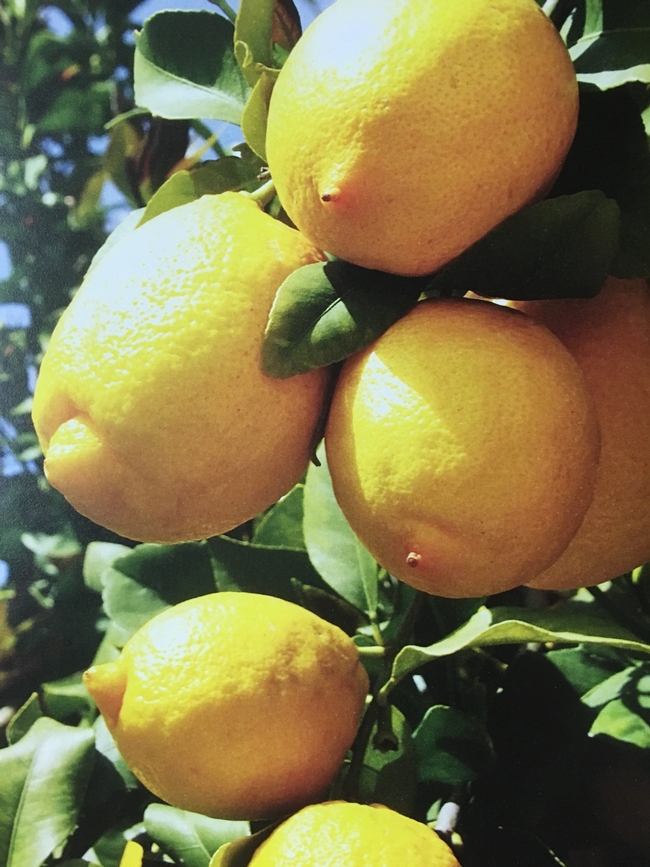
- Author: Ben Faber
There's so much gloom about the fate of citrus in Florida and California, but in spite of that talk, world citrus production is increasing.
Global orange production for 2018/19 is forecast to expand 4.2 million tons from the previous year to 51.8 million as favorable weather leads to larger crops in Brazil and the United States. Consequently, fruit for both fresh and processing uses is expected to be greater. Fresh exports are forecast 4 percent higher to 5.1 million tons.
Brazil's production is forecast to rise 13 percent to 17.8 million tons as favorable weather is expected to result in good bloom and fruit set. Fresh orange consumption and exports are flat while oranges for processing are up 2.0 million tons to 12.8 million.
China's production is projected down slightly to 7.2 million on unfavorable weather, resulting in a smaller crop in Jiangxi province. Along with only a small increase in imports, consumption is
lower on overall reduced supplies. South Africa and Egypt are the top two suppliers, accounting for 60 percent of imports.
U.S. production is forecast to recover, jumping 41 percent to 5.0 million tons due to favorable weather. Orange production in Florida has been declining for years due to citrus greening, which has decimated groves and increased costs for crop maintenance.
However, last year, the industry also suffered from damages caused by Hurricane Irma. This year's higher forecast shows a recovery to recent-year levels. Exports, consumption, and fruit for processing are all higher with the larger crop.
Read more about the world citrus industry and get individual country reports generated by the USDA's Foreign Agricultural Service
https://agfstorage.blob.core.windows.net/misc/FP_com/2019/03/04/Florr.pdf
FAS Reports from Overseas Offices The Citrus: World Markets and Trade circular is based on reports from FAS Overseas Posts since December 2018 and on available secondary information. Individual country reports can be obtained on FAS Online at: http://gain.fas.usda.gov/Pages/Default.aspx .
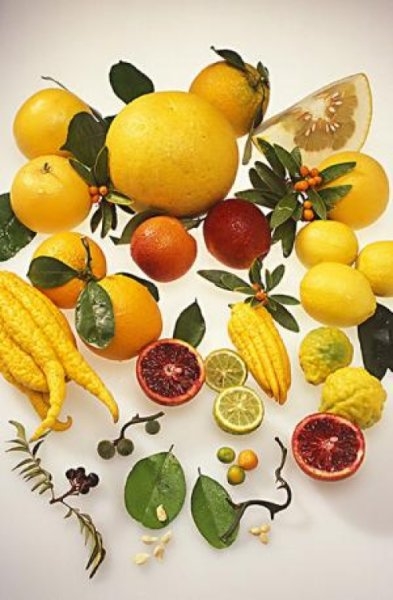
- Author: Ben Faber
Harry S. Smith, was born in 1883 to a poor farming family in Nebraska. He was trained in Biological Control in the northeast U.S.A. where he worked on the biological control of gypsy moth with the USDA. Upon his appointment to Sacramento in 1913 to work on biological control issues important to California, Smith brought recognized entomological training in biological control to California for the first time.
The phrase “Biological Control” was first used by Smith in August 1919 at the meeting of Pacific Slope Branch of the American Association of Economic Entomologists at the Mission Inn in downtown Riverside.
Based on his experiences on biological control of forest and pasture pests, Smith brought caution and tempered exaggeration about biological control in California as he worked with citrus growers and other commodity groups.
 In 1923, Smith and four colleagues moved from Sacramento to the University of California Riverside Campus which had evolved from the Citrus Experiment Station (est. 1915) and he formed the Division of Beneficial Insect Investigations which was a unit distinct from the Division of Entomology. Prof. Harry, as he was
In 1923, Smith and four colleagues moved from Sacramento to the University of California Riverside Campus which had evolved from the Citrus Experiment Station (est. 1915) and he formed the Division of Beneficial Insect Investigations which was a unit distinct from the Division of Entomology. Prof. Harry, as he was
affectionately known, is fondly remembered by his students as a patient and generous supervisor who encouraged research and work on applied and
practical aspects of biological control.
Smith went on to create the Department of Biological Control which offered the only graduate training in Biological Control in the world. The Department of Biological Control became the Division of Biological Control in 1969 which then merged into Department of Entomology at UC Riverside in 1988. Prof. Harry had two sons, both trained to be entomologists. Instead of pursuing biological control they went into the pesticide industry and Sam Smith died accidentally from pesticide poisoning. Prof. Harry passed away in 1957 and left UC Riverside $15,000 to develop a scholarship fund to support training and education in biological control. This fund has grown to approximately $45,000 today, but is insufficient to provide meaningful support to students wanting to be trained in biological control.
Our goal is to build the Harry S. Smith Scholarship fund to a significant level where the corpus of the fund will be able to generate enough revenue to provide substantial support to students wanting to be trained in biological control. This can only be achieved by actively soliciting donations from individuals, industries, and organizations that have benefited over the years from biological control projects that have that have been run by UC scientists, in particular entomologists at UC Riverside. If biological control is to continue to prosper in southern California we need to continue recruiting and training high quality students. To do this, we need to be able to provide substantial financial support, and the Harry S. Smith Scholarship is one way to attract excellent students to UC Riverside.
Learn more about the program and how you can push the fund over the top at:
http://biocontrol.ucr.edu/hoddle/harrysmithfund.html
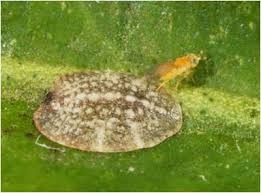
- Author: Sonia Rios
In the fall of 2016 growers in the Coachella desert have been experience very puzzling symptoms on their grapefruit trees. One incident, symptoms the tree had gumming oozing from the branches (Fig. 1). Usually if it were oozing from the stump it would be a root disease such as Phytophthora spp. After photos and branch samples were taken to the Plant Pathologist at University of California, Riverside, Dr. Akif Eskelan, results determined that the trees had branch canker and Hendersonula Disease.
Symptomology
Infection by Nattrassia mangiferae (Hendersonula toruloidea) causes bark cracking and peeling or dead bark that remains tightly attached to dead limbs. Black, sooty growth may develop beneath infected bark. Brownish moist areas appear on limbs during the first stages of disease, then the bark in these areas cracks or peels away revealing black masses of fungal spores (Fig 4.). In advance stages, the injured limbs may “bleed” profusely, oozing a sap like sticky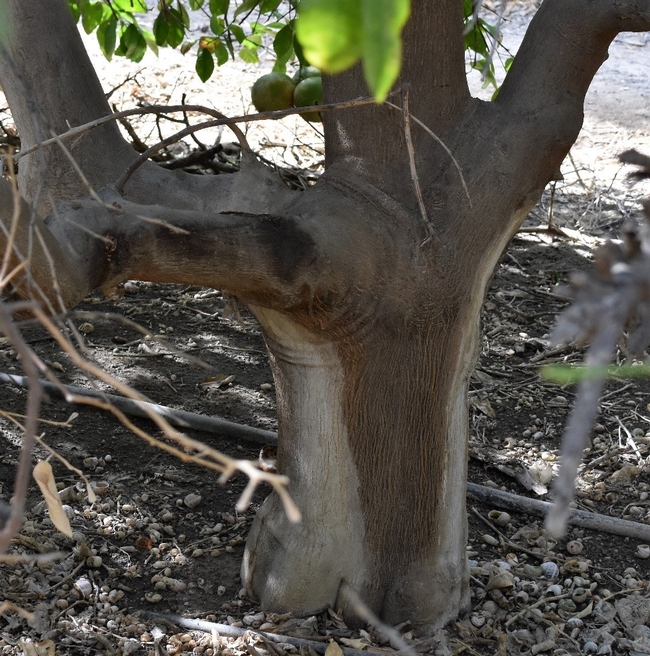
Management
Trees weakened by a disease, water stress, nutritional deficiencies, excessive pruning/mechanical damage create a are more susceptible. As many of these stressors can cause a tree to get sunburned and creates wounds that can serve as infection sites for this pathogen. Prevent sunburn by maintaining vigorous canopies through best management practices http://fruitandnuteducation.ucdavis.edu/generaltopics/ . Proper irrigation, fertilization, pruning, and pest control. Look for symptoms annually right after harvest while there are still healthy leaves on trees. Remove diseased limbs, cutting back to a lateral branch into healthy wood that shows no discoloration. Burn all infested wood, do not chip and use infected wood as mulch.
Additional Resources can be found at:
http://eskalenlab.ucr.edu/handouts/desertdieback.pdf
- Author: Ben Faber
Every year growers get together to learn what is being done in the citrus research world that could affect their operations. This June, University of California and the Citrus Research Board are bringing some good talks to three different growing areas. All growers are invited, but RSVPs are appreciated.
